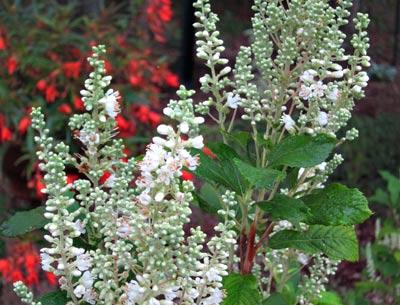Star Gardener: Fragrance in Abundance

Why, you might reasonably ask, should you give space in your garden to a plant that is found all around us?
Fragrance, that is why, and summersweet, or sweet pepperbush, Clethra alnifolia, has it in abundance. It is spicy, somewhat reminiscent of cloves and cinnamon, and a light breeze casts its perfume over a large area.
Clethra would deserve space in the garden even if we spent our August days chasing its scent walking, biking, or tooling in an open car in Northwest, Springs, and Napeague, where it grows along the roadside, mostly on the damp, shady side.
What could be more idyllic than whiling away long August days encased in a bubble of intoxicating fragrance? It commandeers attention, dominating conversation, or, if you are alone, wafting you into a reverie.
The shrub itself is rather modest, with dark green leaves. Its flowers are packed into spires, often clusters of spires, ranging from white to pink. It can bloom from mid-July through August, with some late-flowering cultivars opening in September. Its natural habitat is along the coast from Nova Scotia to Florida and the Gulf Coast to Texas.
Sad to say, the sweet pepperbush is grazed by deer, no matter what the catalogues say. Otherwise it is an easy, disease-free, and adaptable plant for the landscape and garden. Plants can grow to 10 feet and higher, although dwarf and compact cultivars have been introduced recently.
Clethra also suckers, which can be turned to an advantage. For many years a thicket screened off the view of my woodland garden. When the bushes grew too tall, they were easily cut back. Clethra accommodatingly flowers on the current year’s wood so it can be pruned almost any time without sacrificing flowers. If you do not want a thicket or grove, the suckers are easily clipped out.
This year I was ready for a change. I’ve been experimenting with various ways of increasing the depth of view in the garden, creating small vignettes. The bark of clethra, mottled with bright silver, draws the eye. Why not eliminate all but four or five trunks on each bush and limb them up to about four feet? Eureka, the bushes have been transformed from a solid wall into interesting architectural shapes. More important, the silver on the trunks directs the eye toward the woodland garden to the rear, taking in various textures and glimpses of color. What better way to coax visitors toward the path, to explore what lies beyond?
There is nothing inferior about the straight species of Clethra alnifolia. In fact, one that had been left at my house in a pot years ago is superior to some of the named varieties I grow. However, clethra can be leggy and sprawling, so if you purchase a named variety you will know its form in advance.
Many of us on the East End grow, whether we know it or not, C. alnifolia Compacta, which was favored and propagated by Jim Cross, founder of the now-closed Environmentals Nursery on the North Fork. It is denser than the species, and onNorth Fork. It is denser than the species, and only recently, after more than 20 years, have I begun pruning it to keep it under seven feet high.
A number of new cultivars have been introduced recently. A low-growing (maturing to about three feet high), round and compact plant with long, showy racemes of flowers, Crystalina, comes from Dr. Thomas Ranney, one of the best ornamental plant developers working in the U.S. today.
Unless you need a low-growing clethra that suckers profusely, I’d avoid Hummingbird. My only experience with 16 Candles, another low-growing compact bush, was unfortunate. We used it to underplant the white crepe myrtles on Abby Jane’s Path at LongHouse Reserve, and they were destroyed during the winter by deer. So much for slyly introducing fragrance to a planting of crepe myrtles.
Rare Find Nursery is offering a cultivar named Bumblebee, which matures to about three feet and is said to sucker minimally.
Perhaps my favorite of the white cultivars is Anne Bidwell. Its upright, densely clustered spikes of flowers make it unmistakable. The flowers do not open at the same time, so each spike is a combination of tight buds and open blooms, reminding me of an old lace pattern.
The most popular and probably best of the pink-flowered clethra is Ruby Spice. Discovered and introduced by Broken Arrow Nursery in Hamden, Conn., it has received a number of horticultural awards and is widely available. Enough said.
Whether you are caught up in the vogue for native plants or not, the sweet pepperbush deserves a place in every summer garden.
